Methodologies
Forums
Exhibitions
Working closely with journalists from Al Jazeera’s Fault Lines, Forensic Architecture collaborated with Earshot to examine the circumstances surrounding the killing of Hind Rajab, her four cousins, her aunt and uncle, and the two paramedics who came to her rescue.
On 29 January 2024, in Gaza City, Hind Rajab, a six-year-old Palestinian child, pleaded over the phone for emergency workers to rescue her from a car riddled with bullets. Her body was found two weeks later, on 10 February, alongside the bodies of six of her family members in the car they drove to flee their neighbourhood as Israeli forces invaded. The bodies of two Palestine Red Crescent Society (PRCS) paramedics, missing since the evening of the call when they were dispatched to rescue Hind, were discovered in their ambulance about 50 metres away.
The neighbourhood
In an interview with Fault Lines, Wissam Hamada, the mother of Hind Rajab, explained that Hind and six members of her family left in the early hours of 29 January 2024 from a home in the Tel al-Hawa neighbourhood of Gaza City, driving north.
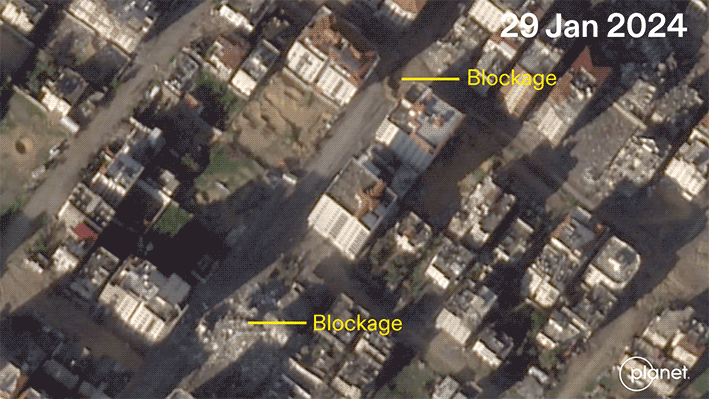
At 9:32am, soon after Hind and her family departed the home, an Israeli military spokesperson posted an evacuation order on social media, asking residents of west Gaza City, including the Tel al-Hawa neighbourhood, to move south. An analysis of satellite imagery (Figure 1) shows that it was not possible for Hind and her family to drive south that morning because the road was blocked by debris from a recently bombed high-rise building.
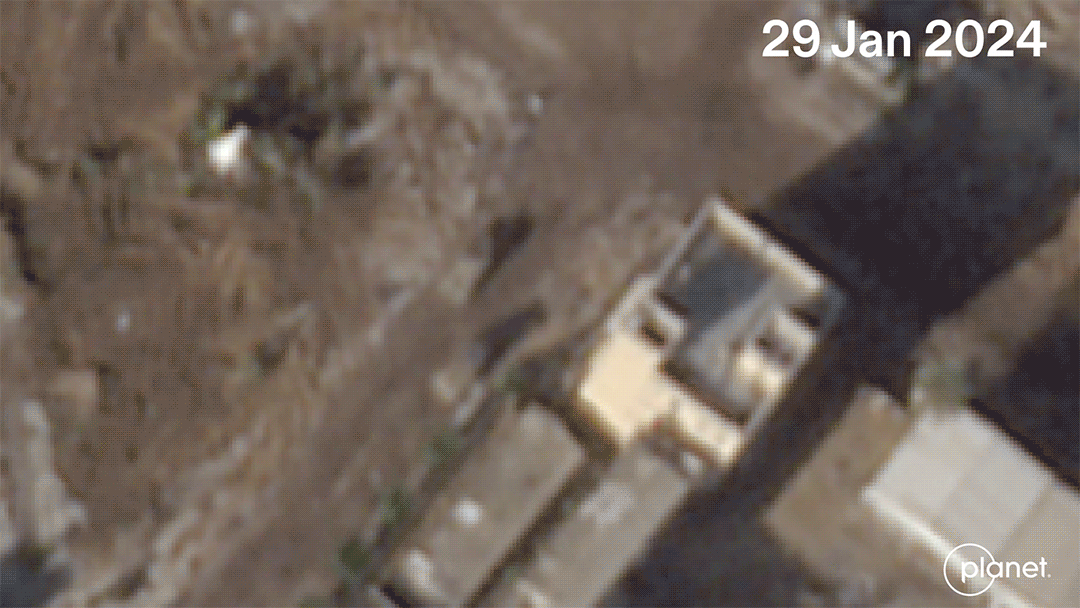
Wissam witnessed shots being fired at the car from an intersection to the north of the home. Many Israeli military vehicles—their shape and size consistent with that of Israeli Merkava tanks—are visible in satellite images (Figure 2) of the intersection from the day of the attack.
‘We saw them open fire but we thought that maybe those in the car were alive because they slightly turned left, so we said they parked at the station. So we thought they must be safe, and they will go to a safe home, that they’ll go to a safe spot.’ – Wissam Hamada
The civilian vehicle
The bodies of Hind and her six relatives were found inside their vehicle, a Kia Picanto. The state of the vehicle was documented by journalists on the ground following the withdrawal of Israeli forces from the area twelve days after the car was attacked.
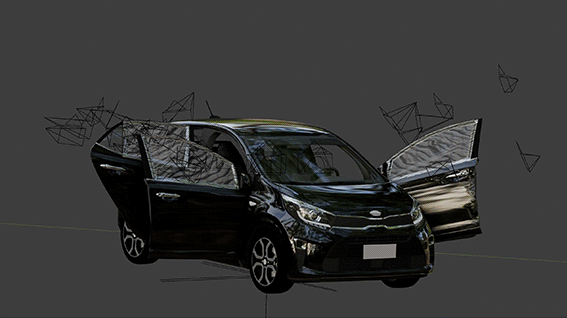
A kinetic analysis of the position and state of the vehicle—rotation of the steering wheel, deformation of the tire, proximity of the driver’s side door to a street sign, and shape of the deformation of the bonnet and front bumper—suggests that the vehicle was pushed from the right-side front bumper.
Furthermore, the shape of the depression of the windshield suggests that it was run over by a vehicle such as a bulldozer.
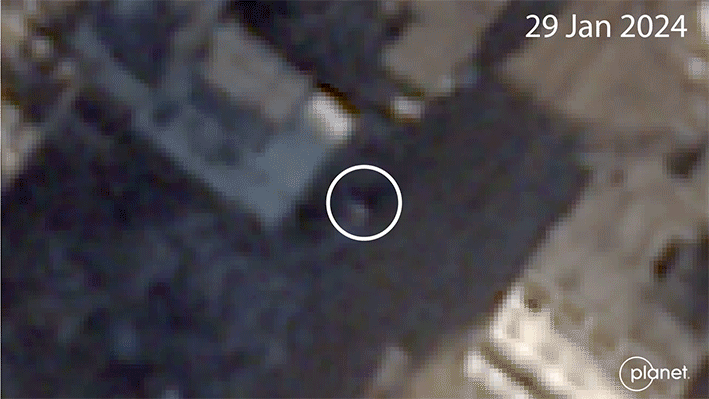
By comparing satellite imagery captured during the twelve days between the attack and the date the evacuation order was lifted, FA was able to map the original position of the Kia Picanto before it was moved. Satellite imagery from 8 February shows the Kia resting on the pavement near a flower bed, where it remained on 10 February. In an image taken on the day of the attack at 3:31pm, the Kia appears parked in front of a gas station.
We used visual evidence to map the bullet marks on the envelope of the vehicle and its interior surfaces. The proximity of the holes to one another helped us identify the volleys of shots fired. The sizes and shapes of the holes helped us to differentiate between entry and exit holes. We mapped a total of 335 bullet holes on the body of the Kia. Most entries were located on the right side of the vehicle, suggesting the position of the shooters.
The killing of Layan Hamada
Around 2:30pm, the first call to Palestine Red Crescent Society dispatchers came from Layan Hamada. At that time, Layan was the only other survivor in the car besides Hind. The Red Crescent later published a 28-second clip from their recording of the call. An excerpt is translated below:
Layan: They are shooting at us. The tank is next to me.
Operator: Are you hiding?
Layan: Yes, in the car. We’re next to the tank.
After a series of audible shots, Layan can be heard screaming until her voice stops abruptly, twenty seconds into the call.
According to an analysis of the recording by Earshot, in the final moments that we hear Layan’s voice, a total of 64 gunshots can be heard, fired in just 6 seconds. The gun firing these shots is firing at a range of 750–900 rounds per minute. This range exceeds that of an AK-type rifle, the assault rifle most commonly attributed to Hamas. This range of rounds per minute is consistent with Israeli army-issued weaponry such as the M4 assault rifle or the FN MAG machine gun on a Merkava tank.
When gunfire is captured by a recording device, there are two distinct sounds that are typically audible. First, the sound of the bullet traveling at supersonic speed. Second, the blast from the muzzle of the gun reaching the recording device at the speed of sound. While the bullet sounds akin to a whip cracking, the muzzle blast is a low-frequency thud. Investigators at Earshot distinguished these two sounds in the recording and used the interval between them to determine the distance between the shooter and the recording device.
Due to the condition of the recording, the noise of the screams, and the rapid succession of bullets impacting the vehicle, it was only possible to distinguish the supersonic sound of the bullet from the muzzle blast for 12 of the 64 shots. The time between bullet impact and muzzle blast ranges from a minimum of 24 milliseconds (shot 29) to a maximum of 40 milliseconds (shot 62).
The spectrographic image shown in Figure 7 (above) reveals the intensity of the frequencies over time for these two gunshots. The X-axis is time, the Y-axis is the frequency range from low to high, and the brightness is the intensity. In the three-dimensional spectrograph of the two gunshots, one can clearly distinguish the signature of the supersonic bullet peaking in the mid-to-high range frequencies from the lower frequencies of the muzzle blast.
Seconds before Layan Hamada is killed, she is heard saying, ‘They are firing at us, the tank is next to me’. The Merkava tank FN MAG machine gun fires 7.62 calibre bullets. These bullets travel at a speed of 840 metres per second. The muzzle blast from the gun that fired these shots was traveling at 340.2 metres per second, which is the speed of sound at the time of the killing at a temperature of 15 degrees Celsius.
Earshot found that with the minimum registered interval of 24 milliseconds, this tank would have to have been positioned just 13 metres away from the car. With the maximum interval of 40 milliseconds, the tank would have still been only 23 metres away from the car. This analysis suggests that the tank had to be positioned within close range (13–23 metres) of the car when it fired the shots that killed Layan. At such proximity, it is not plausible that the shooter could not have seen that the car was occupied by civilians, including children.
Earshot’s audio ballistic analysis supports the final words of Layan Hamada: the gunfire came from a tank that was next to them.
Taking into account the radius from which the shots were likely fired (13–23m), the location of Hind and Layan within the car (left rear passenger seat), and the alignment of the entry and exit holes on the Kia, we developed a simulation to map the most likely position of the tank at the time of the shooting.
The highlighted area on the grid is the position where the entry and exit holes align most closely. From the tank position indicated by the greatest alignment between entry and exit holes, we concluded that the shooter would have had a clear view of the car and its passengers. In other words, they would have been aware of the presence of two children.
The killing of the paramedics: Yusuf al-Zeino and Ahmed al-Madhoun
After Layan was killed, six-year-old Hind was the sole survivor in the car. Palestinian Red Crescent dispatchers made and maintained intermittent contact with Hind via phone. Permission for an ambulance to proceed to Hind’s location arrived at 5:40pm, shortly after sunset. Evidence gathered by Fault Lines shows that paramedics Yusuf al-Zeino and Ahmed al-Madhoun were dispatched in an ambulance from al-Ahli Hospital. They reached the site at about 6pm and were shot at upon arrival.
Control room: Can you see the car?
Ambulance: I can’t see a thing here.
Control room: Do you have your siren and flashing lights on?
Ambulance: Just the lights, not the siren.
Ambulance: … oh there it is!
[explosion]
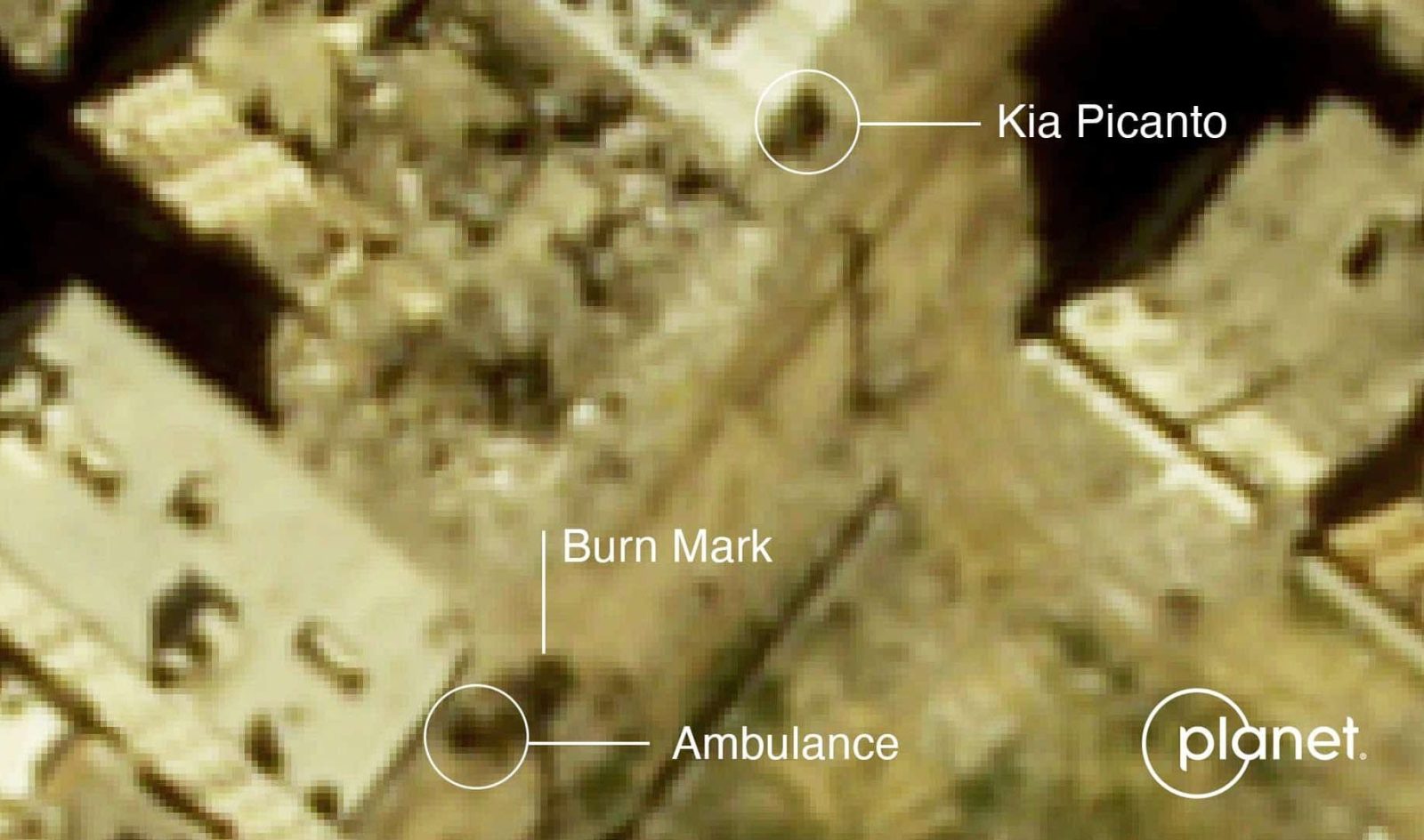
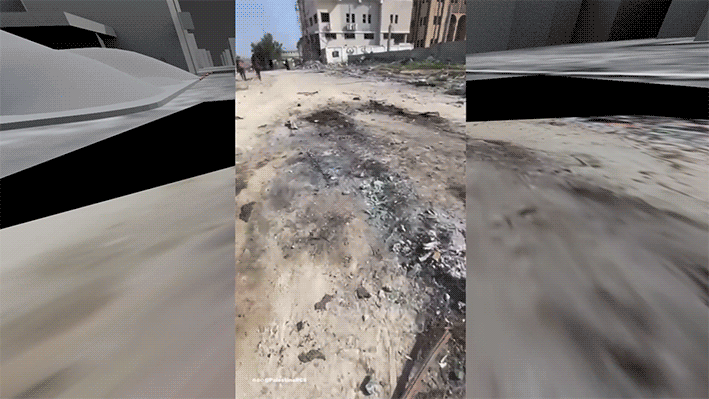
Satellite imagery (Figure 10) from days after the incident shows a large burn mark on the ground in front of the wrecked ambulance. This burn mark is consistent with imagery shared with us by Al Jazeera from the day the evacuation was lifted. By photomatching stills from video documentation of the ambulance from 10 February, we reconstructed and mapped the burn marks within a 3D model (Figure 11). This helped us estimate the position of the ambulance before it was hit and lost contact with the PRCS dispatchers.
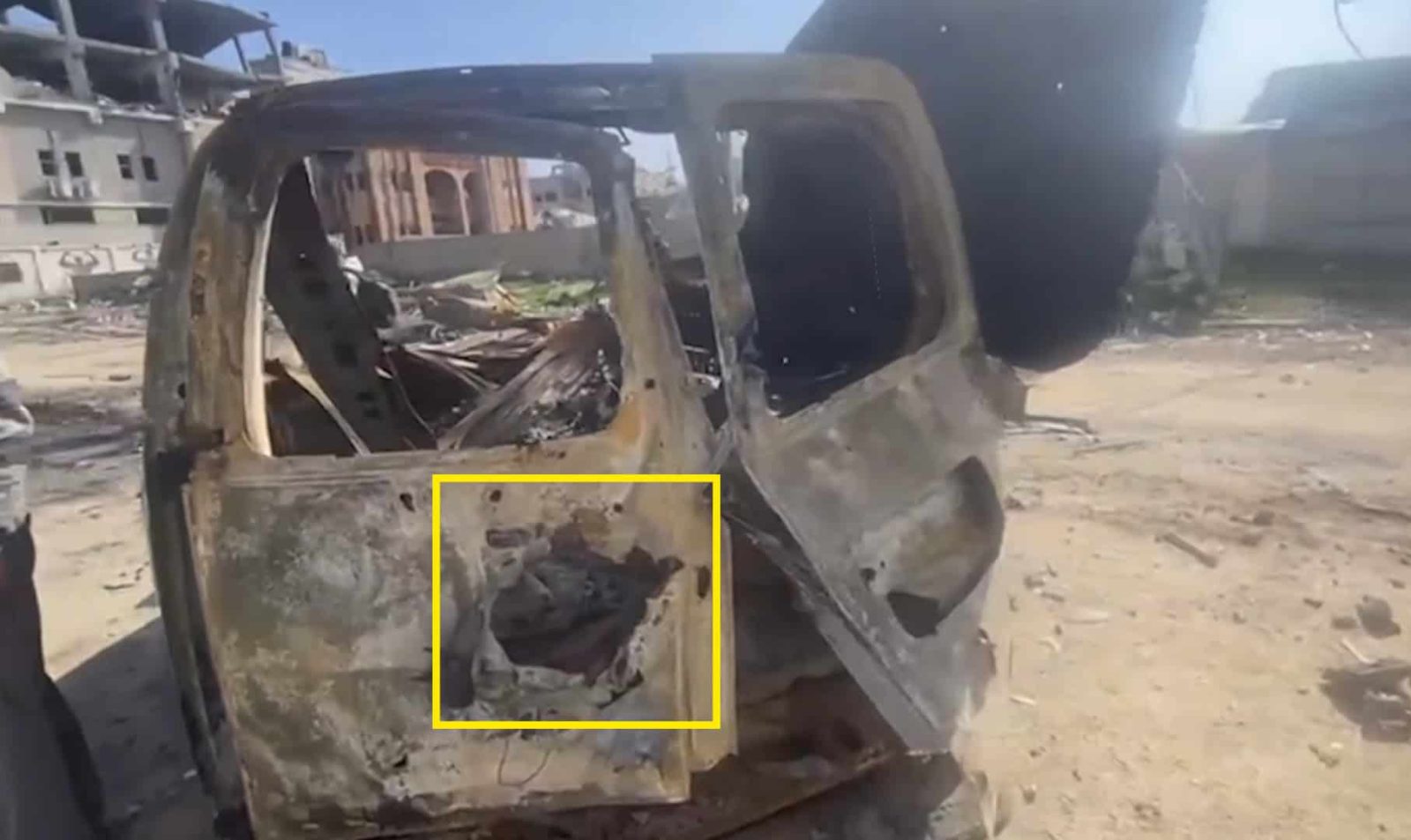
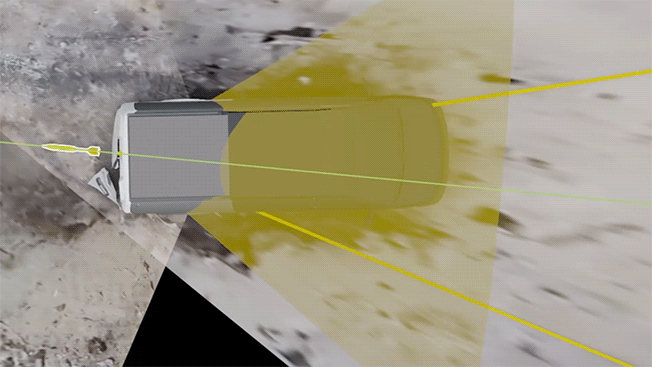
We identified an exit hole of approximately 23x26cm in the left rear door of the ambulance (Figure 12). A sabot, which is a part from a 120mm M830A1 High Explosive Anti-Tank Multi-Purpose-Tracer (HEAT-MP-T) round, was found on-site near the vehicle. The size of the exit hole is consistent with the impact of an M830A1 HEAT-MP-T round.
Comparing the exit hole and varying levels of destruction helps reconstruct the cone of impact from the explosion, and in turn, reveals the direction from which the ambulance was shot (Figure 13). This direction is consistent with the location of Israeli tanks visible in satellite imagery from between 29 January and 8 February.
Our assessment of the position of the tanks at the time of the attack, together with the direction of the shot, suggests that the ambulance was likely hit by ammunition from an Israeli tank.
The killing of Hind Rajab
Two weeks later, on 10 February, Hind’s body was found in the car alongside the bodies of her family members. The bodies of the paramedics, missing since the evening they were dispatched to rescue Hind, were discovered in the ambulance about 50 metres away from the car.
Update
 24.06.2024
24.06.2024
In 24 June press briefing, the spokesperson for the US Department of State, Matthew Miller, was questioned by a journalist about the findings from FA and Earshot’s investigation into the killing of Hind Rajab. Miller was pushed for answers about the status of the case and the source of the fatal shots that killed Hind.
Update
 28.06.2024
28.06.2024
The findings of Forensic Architecture and Earshot in the case of Hind Rajab were presented in the US House of Representatives by congresswoman Rashida Tlaib on 28 June 2024. The link to FA’s investigation was entered into the congressional record alongside the investigation’s major findings.
Update
 22.10.2025
22.10.2025
On 21 October 2025, Al Jazeera and the Hind Rajab Foundation released a documentary, The Tip of the Iceberg, featuring our analysis of the circumstances surrounding the killings of Hind Rajab, her family, and two Palestinian Red Crescent paramedics. The documentary reveals the identities of the Israeli battalion, company, and commanders responsible for their killings.
The Hind Rajab Foundation subsequently submitted a 120-page Article 15 filing to the International Criminal Court (ICC) in The Hague. The filing directly names 24 Israeli soldiers and commanders who directly participated in or facilitated the attack. The Foundation’s legal team concludes that these acts amount to war crimes, crimes against humanity, and genocide, under Articles 6, 7, and 8 of the Rome Statute.